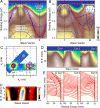Fermi surface nesting induced strong pairing in iron-based superconductors
- PMID: 19359490
- PMCID: PMC2667370
- DOI: 10.1073/pnas.0900469106
Fermi surface nesting induced strong pairing in iron-based superconductors
Abstract
The discovery of high-temperature superconductivity in iron pnictides raised the possibility of an unconventional superconducting mechanism in multiband materials. The observation of Fermi-surface (FS)-dependent nodeless superconducting gaps suggested that inter-FS interactions may play a crucial role in superconducting pairing. In the optimally hole-doped Ba(0.6)K(0.4)Fe(2)As(2), the pairing strength is enhanced simultaneously (2Delta/T(c) approximately 7) on the nearly nested FS pockets, i.e., the inner hole-like (alpha) FS and the 2 hybridized electron-like FSs, whereas the pairing remains weak (2Delta/T(c) approximately 3.6) in the poorly nested outer hole-like (beta) FS. Here, we report that in the electron-doped BaFe(1.85)Co(0.15)As(2), the FS nesting condition switches from the alpha to the beta FS due to the opposite size changes for hole- and electron-like FSs upon electron doping. The strong pairing strength (2Delta/T(c) approximately 6) is also found to switch to the nested beta FS, indicating an intimate connection between FS nesting and superconducting pairing, and strongly supporting the inter-FS pairing mechanism in the iron-based superconductors.
Conflict of interest statement
The authors declare no conflict of interest.
Figures



References
-
- Damascelli A, Hussain Z, Shen ZX. Angle-resolved photoemission studies of the cuprate superconductors. Rev Mod Phys. 2003;75:473–541.
-
- Campuzano JC, Norman MR, Randeria M. In: The Physics of Superconductors. Bennemann KH, Ketterson JB, editors. Vol II. Berlin: Springer; 2004. pp. 167–273.
-
- Matsui H, et al. Direct observation of a nonmonotonic dx2-y2-wave superconducting gap in the electron-doped high-Tc superconductor Pr0.89LaCe0.11CuO4. Phys Rev Lett. 2005;95 017003. - PubMed
-
- Blumberg G, et al. Nonmonotonic dx2-y2 superconducting order parameter in Nd2-xCexCuO4. Phys Rev Lett. 2002;88:107002. - PubMed
-
- Ding H, et al. Angle-resolved photoemission spectroscopy study of the superconducting gap anisotropy in Bi2Sr2CaCu2O8+x. Phys Rev B. 1996;54:R9678. - PubMed
Publication types
LinkOut - more resources
Full Text Sources
Research Materials

